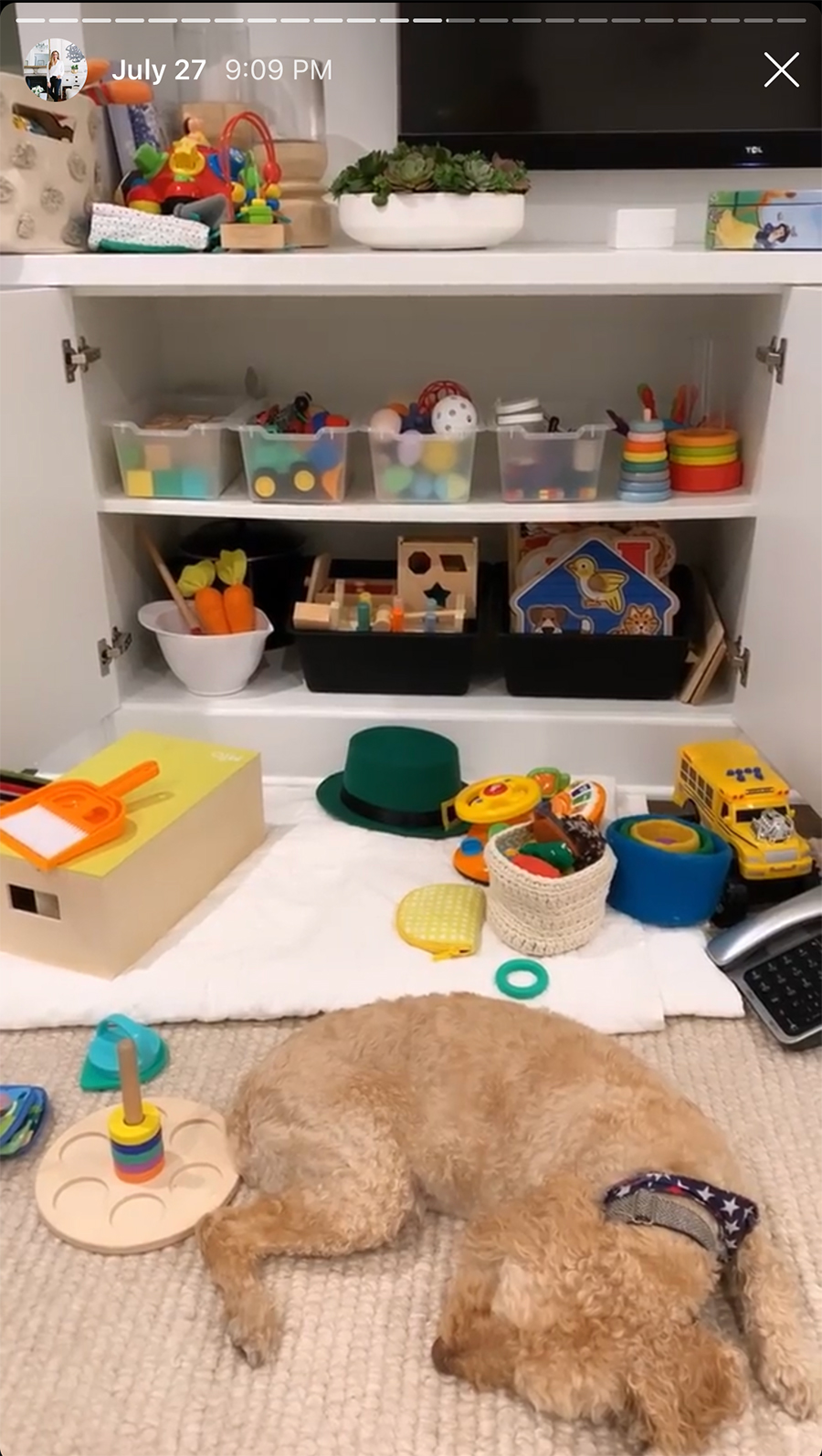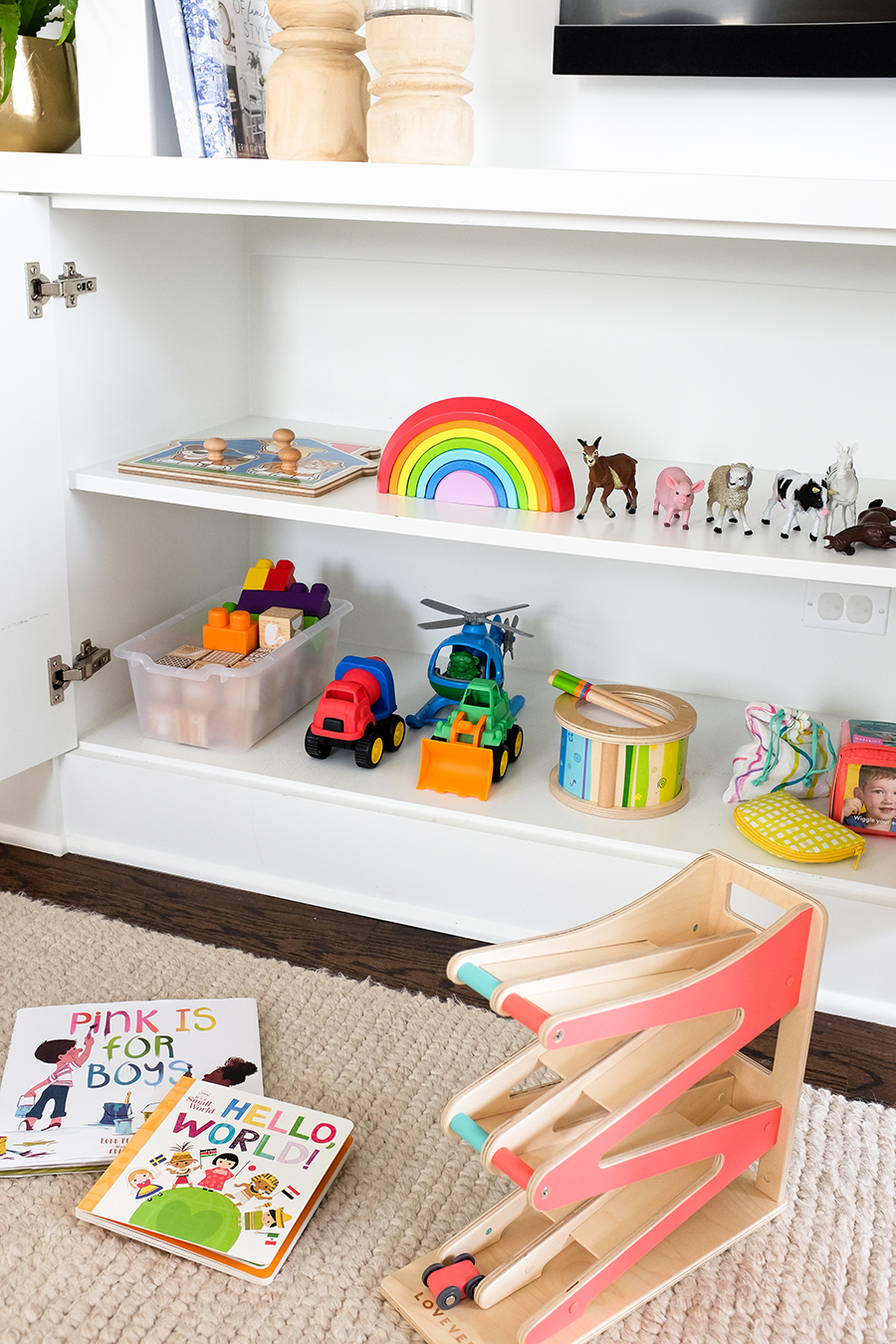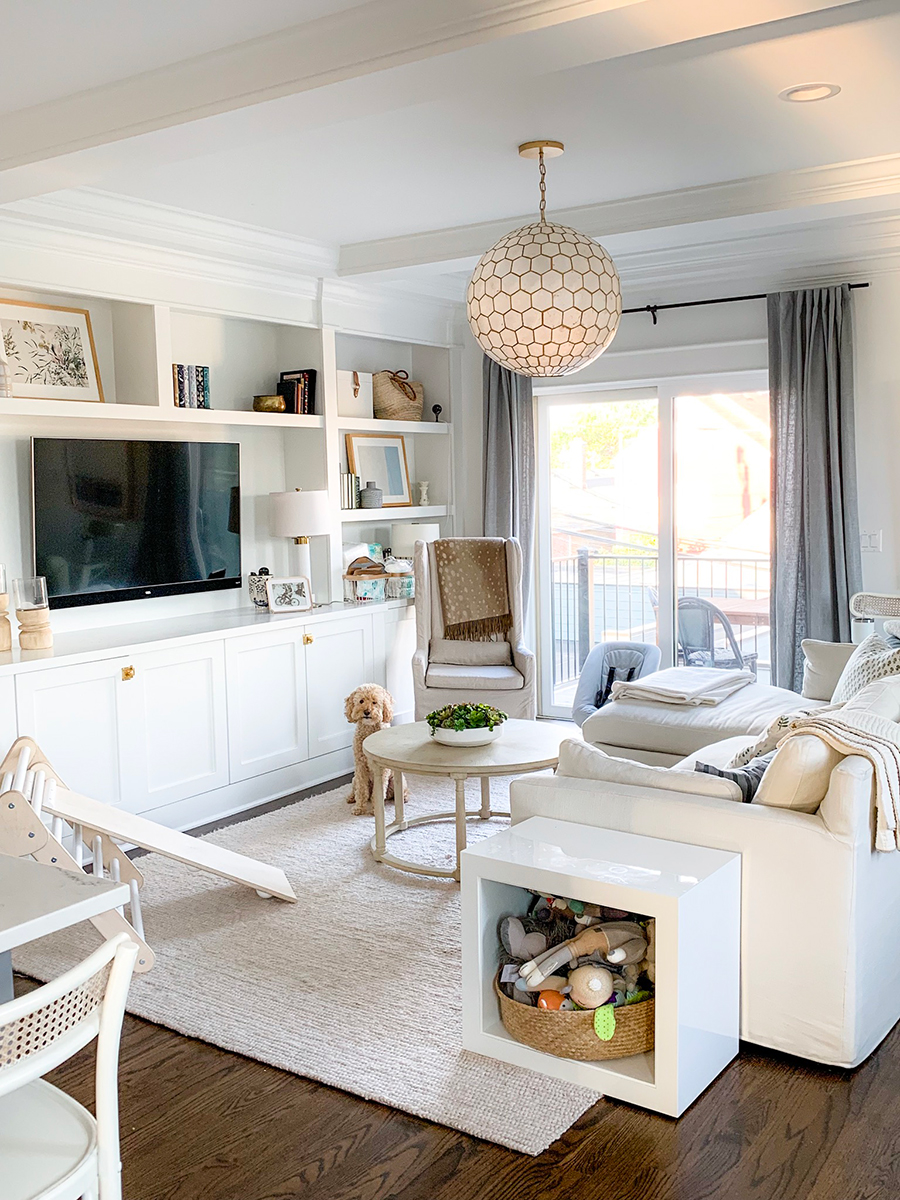Once we have kids, I really don’t want our home to be overrun by toys and kids’ stuff. Oh, the sweet, naive dream of my pregnant self.
Rewind to this pre-mom version of me: it was fall 2017, and I found myself expecting my firstborn, Henry. My husband and I were excited and surprised and nervous all at the same time. How would life change? How would having a baby affect work, our relationship, our home, our pets?
We had friends and siblings with little ones, and I saw how quickly children can take over a home. Entire living areas transform into playrooms; walls become giant art canvases; and kitchen counters are held hostage to endless piles of, well, no one really knows what. Not to mention every doorway, toilet, cabinet, and sharp corner becomes a death trap for your little one. But I was determined.
Every baby item I registered for—from the changing pad to the swaddles down to the pacifiers—blended flawlessly with our home design. If there was a beautiful version of the baby item, I found it.
Initially, this plan worked pretty well. Sure, there were almost always bottles drying on the counter, and there was a playmat permanently stationed in the middle of the family room rug for a few months—but overall, our home still looked like adults lived there and not just children.

Source: Alaina Kaz
That first year we had kept the toys fairly minimal, relying heavily on a bi-monthly Montessori toy* subscription box by the company Lovevery (that I can’t say enough great things about).
Each day we’d lay out a bunch of toys for him to play with, displayed in a nice circle which really helped foster independent play. At night once he was in bed, I’d quickly stow away everything, and our family room would be restored to a calming respite for mom, dad, and Netflix. Then, our little babe turned 1.
*By definition, a Montessori toy is typically one made of natural materials like wood or fabric, designed to encourage kids to explore and discover independently. So, instead of going for tricked-out toys that move and make sounds on their own, these are passive toys that require your child to physically manipulate them and incorporate them into their pretend play.
How Toddlerhood Changed All of This
Henry was no longer just a baby who sat, smiled, cried, and played with what you put in front him. He began walking. And he began exploring. And opening cabinets. Namely: his toy cabinet. And pulling things out of cabinets. And throwing things. And asking for more.

Source: Alaina Kaz
Throughout the year, a few light-up, sound-making toys with 14 pieces made their way into the mix. And, as any experienced mom knows, babies grow fast, and their developmental needs change at lightning speed, so while I’ve never been an advocate of “buy anything and everything your kid wants,” this was our first kiddo, and we didn’t have anything for whatever new stage he was entering.
So, I’d regularly find myself on Amazon searching for the next stage of toy he needed to keep his busy mind and growing body stimulated. By the time Henry was 1, I was already pregnant with our second boy, so I figured anything we bought would get a ton of use between Henry and his baby brother—which really just opened the floodgates of justifying new toy and book purchases.
Slowly but steadily, the toys began to accumulate. He had always had a pretty good attention span for his age, but we noticed things he once loved were no longer holding his interest. “Oh, he’s outgrown it already,” I figured. So, I’d do some research on age-appropriate toys, and add some new exciting playthings to the mix.
All of a sudden, there was a tunnel to crawl through, a Pikler climber to scale, a basketball hoop to play with, blocks to stack, puzzles to piece together, new books to read—he loved it all! Until he didn’t.
This need to keep adding to his toy and entertainment collection lasted for about two months until one day I realized our family room had transformed into a one-baby daycare. There was a mountain of toys covering the floor by the end of the day.
The unmanageable mess was one thing, but what really struck me was that Henry wasn’t really playing with any of it. He’d pull it all out, only to go back to the toy cupboard and grab the next thing. He wasn’t spending much time with any one item and was always looking for the next thing—a drastic change from his younger, fewer-toy options self.
The constant mess was stressing me out and having too many options wasn’t doing Henry any favors. We needed a solution.
Why I Was Drawn to the Montessori Method
My first attempt was to tackle the mess. I picked up some really inexpensive bins in the dollar section at Target and organized every toy, grouping and stowing them by balls, things that move, blocks, wooden toys, puzzles, etc. Huge improvement.

Source: Alaina Kaz
But the cupboard still looked so cluttered. It was overwhelming to me, let alone a 1-year-old child. And let me tell you—it was time-consuming work making it look that tidy. Not something my husband nor I could easily spend time doing night after night.
Then, I came across the book The Montessori Toddler: A Parent’s Guide to Raising a Curious and Responsible Human Being. This officially became the second parenting book I’ve read (the first being French Children Don’t Throw Food—they’re similar in that both books advise on a non-helicopter, encourage independence approach to parenting).
I cannot recommend The Montessori Toddler enough. It’s a quick read and a beautiful book, but most importantly, I’m a huge fan of the Montessori theory. The theory is based on using a toddler’s natural developmental stages and encouraging their curiosity, learning, respect, and ability to discover. The book itself breaks down these ideas in a really practical way and offers advice to parents in order to create a home environment that nurtures independence and self-guided exploration. By following this approach, the book says that parents can implement routine and limits with love and eliminate chaos and clutter from the home.
Yes, yes, yes—I am so here for this, I thought as I read. Dozens of underlined passages and dog-eared pages later, the book provided me with endless nuggets of inspiration and clear takeaways, and the next day, I got to work. Once Henry was in bed, I tore open the toy cupboard, pulled everything out, recruited my husband to help, and began to Montessori the crap out of his toys.
As you can even see on the book’s cover, the Montessori method means fewer toys presented to the child at a time and displayed in a tidy manner so that they can clearly choose one toy at a time to focus on. This Everymom article on bringing the Montessori method home is a great, brief intro to the theory.
If you follow me on Instagram, you saw this all go down one evening as I documented it in my Stories. It took several hours and two of us working together since “paring back the toys” meant needing to get creative and find alternative storage for 80 percent of Henry’s toys in our other cabinets and closets. Those also needed to be organized but accessible, as the plan was to rotate out the assortment Henry was given to play with at any one time.
How We Implemented This

Source: Alaina Kaz
Here is the gist of what we did:
1. Pull everything out of the toy cupboard
2. Sort toys into groups by purpose
- toys for building (wooden blocks, connectors, stacking blocks, etc.)
- toys that move (toy cars, trains, etc.)
- toys to teach vocabulary (animal figurines, flashcards, etc.)
- toys for active play and gross motor skills (some of his larger items like the tunnel, basketball hoop, ride-on toy, climber, etc.)
- toys that require task completion and using fine motor skills (stacking triangle, infant coin box, hammer and pegs, etc.)
- toys that make music (drum, xylophone, etc.)
- puzzles
- arts and crafts toys
3. Keep one to two items per group on the toy shelf, clearly displayed and accessible for the child to reach.
4. Store the others where he can’t access them but that I can easily get to for toy rotation within a few weeks (i.e. if we had three puzzles, one stayed available in his toy cupboard, the other two were stored away and would be switched out at a later date).
I did not include books in this reorganization, even though there is a method for book rotation. For the most part, he has access to all of his books, and they are stored in almost every room of our home. Again, I’m a big believer in doing what makes sense for your household.

Source: Alaina Kaz
Once the toys are sorted, we demonstrated the Montessori method of play, which is better detailed in the book. It basically delineates playing with one item at a time and putting it back when finished. I think Henry is still a little too young to get this wholly, but we will keep trying to encourage it. Right now, my main goal is to get him helping with clean-up.
The End Results
The overwhelming end of day mess? No longer an issue.

Source: Alaina Kaz

Source: Alaina Kaz

Source: Alaina Kaz

Source: Alaina Kaz
Having fewer toys out means a lot less mess to clean up each day, and encouraging Henry to help place things back where they belong makes end-of-day clean-up a reality again—and it’s a reality that I was close to giving up on a couple of months ago.

Source: Alaina Kaz
My stress level of living in chaos has subsided, and my husband and I can actually kick our feet up and relax after bedtime instead of tackling a mountain of mess created by our little one. Well, once we do all of the dishes and fold the laundry and walk the dog and the million other things parents have to do, of course. But at least it’s one less thing!
Henry’s attention span and interest in each individual toy? Back and better than ever.
The first morning after we Montessori-ed his toys, Henry opened the cabinet door and looked at me. I’m sure his baby brain was running through some confused version of: eight toys?! What the what?! Where did all of my things go?! MOM!
But I proceeded to talk to him about each of his toys—which was easy to do since the few that were out were all clearly on display and ready to be played with.
Henry, would you like to build a tower with your blocks?
We can play with these animals.
Or we can make music with this drum.
Or we can put this puzzle together.
Eventually, he grabbed one and got to work tinkering, totally focused, and not overwhelmed with decision fatigue or overstimulation of “what should I play with next?!”
Per the guidelines, I switched out some toys that I saw he was no longer as interested in one to two weeks later. Two to three weeks later, I did it again. Most recently, I reintroduced his Pikler climber and slide, and he’s not only obsessed with it now, but can also climb and play in a way his younger body couldn’t. He climbs over it, slides down it, and plays with it every day. Prior to the pare down, the climber just sat there unused, taking up space.
We watch his play closely, and when he loses interest (doesn’t engage with it in a day), we’ll store it away for a few weeks before bringing it back out. New toys appearing every few weeks means it’s like Christmas morning all the time but without mom and dad having to go buy new things.
Is This Right for Your Family?
As with any parenting method or philosophy, this method isn’t for everyone.
We like this philosophy because along with making a mess and playing freely, Henry is also learning to focus, help around the house, make independent decisions, and not require constant parent entertainment—these are all values that are important to us as a family. So, finding a way to do this in our home and with our child is exactly right for us.
The full Montessori method also encourages us to metaphorically close the toy cupboard and get outside or open up a box of crayons and create or get into the kitchen and bake. It promotes a variety of activities and interests, and that’s something we believe in. Creating an age-appropriate environment that encourages creativity, focus, and independence is what we want to do, and this is one way to do it.
I’ve slowly started implementing the other methods from the book, such as simple household chores he can help with—like getting his own plate or cup, helping pick out his clothes, putting clothes in the hamper—and encouraging exploration outdoors, etc. The activities ramp up at 18-24 months, and I’m excited to see what’s next for my little babe.

Source: Alaina Kaz
So far, we’ve loved this method for Henry’s toys, and it’s working for us. And if you’re in a similar situation or finding yourself and your little one encountering the same struggles as we did, it’s worth giving a try!



 "
"


























